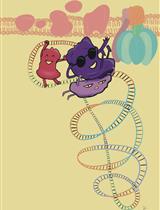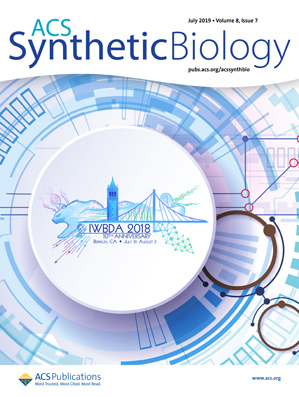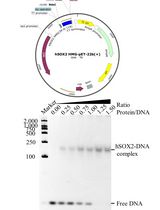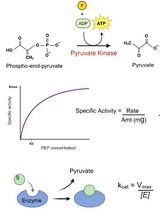- EN - English
- CN - 中文
High-level Production of Recombinant Membrane Proteins Using the Engineered Escherichia coli Strains SuptoxD and SuptoxR
利用工程大肠杆菌SuptoxD和SuptoxR高效生产重组膜蛋白
发布: 2020年08月05日第10卷第15期 DOI: 10.21769/BioProtoc.3710 浏览次数: 5129
评审: Ali Asghar KermaniThibaud T. RenaultAnonymous reviewer(s)

相关实验方案

重组人线粒体RNA聚合酶(POLRMT)及启动因子TFAM和TFB2M的表达和纯化
An H. Hsieh [...] Tatiana V. Mishanina
2023年12月05日 2425 阅读
Abstract
We have previously described the development of two specialized Escherichia coli strains for high-level recombinant membrane protein (MP) production. These engineered strains, termed SuptoxD and SuptoxR, are capable of suppressing the cytotoxicity caused by MP overexpression and of producing greatly enhanced MP yields. Here, we present a Bio-protocol that describes gene overexpression and culturing conditions that maximize the accumulation of membrane-integrated and well-folded recombinant MPs in these strains.
Keywords: Recombinant protein production (重组蛋白生产)Background
MPs perform a variety of critical functions in the cells of all living organisms (Wagner et al., 2006; Schlegel et al., 2010) and constitute major targets for current and future pharmaceuticals (Yildirim et al., 2007). Acquiring sufficient amounts of isolated protein is a prerequisite for their biochemical and structural studies, which in turn can lead to a deeper understanding of their functions and the discovery of new MP-targeting drugs.
Because MPs are typically encountered in their native environments at very low abundances, heterologous hosts have been routinely used for their recombinant overexpression and subsequent purification. Many different systems have been utilized as overexpression hosts for a large variety of MPs of both prokaryotic and eukaryotic origin (Wagner et al., 2006). Among these, Escherichia coli has been one of the most popular ones, owing to its very low cost and ease of use (Makino et al., 2011). Indeed, this bacterium has been successfully utilized for the production of approximately 20% of all recombinantly produced MP structures that are deposited in the Protein Data Bank (Dilworth et al., 2018). Despite these advantages and successes, the use of E. coli as a heterologous host for MP production is often accompanied by severe toxicity, low levels of final biomass and minute final yields (Miroux and Walker, 1996; Wagner et al., 2007; Link et al., 2008; Gubellini et al., 2011).
In order to address these challenges, we have recently developed two specialized E. coli strains, named SuptoxD and SuptoxR, which enable high-level production of recombinant MPs (Gialama et al., 2017a and 2017b). When used as expression hosts, these strains exert a dual positive effect compared to wild-type bacteria:
(1)They suppress the toxicity that frequently accompanies the MP overexpression process, thus enabling enhanced levels of final bacterial biomass, and
(2)They markedly increase the cellular accumulation of membrane-incorporated and properly folded protein.
Combined, these two positive effects result in dramatically enhanced volumetric yields for various recombinant MPs (Gialama et al., 2017a and 2017b). Importantly, these strains have been optimized to enable the production of high-quality recombinant MPs at quantities sufficient for functional and structural studies (Michou et al., 2019). Up to now, we have tested a broad panel of recombinant MPs of both prokaryotic and eukaryotic origin and with different characteristics, all of which are described in Gialama et al. (2017a and 2017b) and in Michou et al. (2019).
The toxicity-suppressing and cellular production-promoting capabilities of SuptoxD and SuptoxR are based on the overexpression of either one of the effector genes djlA or rraA, respectively (Gialama et al., 2017a). DjlA (DnaJ-like protein A) is a single-pass integral MP that functions mainly as a co-chaperone for the central bacterial molecular chaperone DnaK (Clarke et al., 1996). On the other hand, RraA (Regulator of ribonuclease activity A) is known to act as a regulator of the mRNA-degrading activity of RNase E, and rraA overexpression has been found to affect the levels of more than 2,000 different mRNAs in E. coli (Lee et al., 2003). We have previously found that (i) DjlA and RraA act independently, i.e., the beneficial effects of each protein on recombinant MP production occur through a mechanism that does not involve the other, and in a non-additive manner; (ii) full-length and membrane-bound DjlA is required for exerting its beneficial effects on recombinant MP production in E. coli SuptoxD; (iii) the MP production-promoting properties of DjlA in SuptoxD are mediated through the action of the molecular chaperone DnaK; (iv) the observed RraA-mediated effects in E. coli SuptoxR involve the ribonucleolytic activity of RNase E; and (v) DjlA and RraA are unique among similar E. coli proteins in their ability to promote bacterial recombinant MP production (Gialama et al., 2017b). The exact molecular mechanism with which DjlA and RraA suppress MP-induced toxicity and enhance recombinant MP production in E. coli SuptoxD and SuptoxR, respectively, is still under investigation.
Here, we present a protocol that describes gene overexpression and culturing conditions that maximize the accumulation of membrane-integrated and well-folded recombinant MPs when using SuptoxD and SuptoxR. As structural biology of MPs has entered a new era, we believe that these specialized strains will be broadly utilized to address some of the important challenges of MP production and will facilitate the acquirement of sufficient quantities of high-quality recombinant MPs.
Materials and Reagents
- Nylon-membrane Syringe filter 0.2 μm pore size, 25 mm diameter, sterile (Corning, catalog number: CLS431224 )
- HiLoad Superdex 200 16/600 column (GE Healthcare, catalog number: GE28-9893-35 )
- Sterile pipette tips, 10-200 µl (Greiner Bio, catalog number: 739290 )
- Sterile pipette tips, 200-1,000 µl (Greiner Bio, catalog number: 740290 )
- Sterile culture tubes (Sigma-Aldrich, catalog number: C1048-72EA )
- Sterile closures for culture tubes (Sigma-Aldrich, catalog number: C1298-100EA )
- Sterile centrifugation tubes 1.5 ml (Eppendorf, catalog number: 616201 )
- Sterile Falcon tubes 15 ml (Greiner Bio, catalog number: 188271 )
- Sterile Falcon tubes 50 ml (Greiner Bio, catalog number: 227261 )
- Semi-micro-cuvettes (Greiner, catalog number: 613101 )
- Polypropylene centrifuge bottles, 500 ml (Celltreat, catalog number: 229468 )
- Polycarbonate ultracentrifuge bottles, 3 ml (Beckman, catalog number: 355618 )
- Polypropylene chromatography columns, 5 ml (Pierce, catalog number: 29922 )
- Amicon® Ultra-15 Centrifugal Filter Unit (Merck, catalog number: UFC901024 )
- 96-well black plates for fluorescence measurements (Greiner, F-bottom, catalog number: 655076 )
- Polyvinylidene fluoride (PVDF) membrane (Merck, catalog number: IPVH00010 )
- E. coli SuptoxD cells
Genotype: F- λ– Δ(ara-leu)7697 [araD139]B/r Δ(codB-lacI)3 galK16 galE15 e14- mcrA0 relA1 rpsL150(StrR) spoT1 mcrB1 hsdR2(r-m+) pSuptoxD
Note: E. coli SuptoxD carry either the pSuptoxD or the pSuptoxD[untagged] plasmid (see below). - E. coli SuptoxR cells
Genotype: F- λ– Δ(ara-leu)7697 [araD139]B/r Δ(codB-lacI)3 galK16 galE15 e14- mcrA0 relA1 rpsL150(StrR) spoT1 mcrB1 hsdR2(r-m+) pSuptoxR
Note: E. coli SuptoxR carry either the pSuptoxR or the pSuptoxR[untagged] plasmid (see below). - E. coli MC1061 cells (Coli Genetic Stock Center, catalog number: 6649 )
Genotype: F- λ– Δ(ara-leu)7697 [araD139]B/r Δ(codB-lacI)3 galK16 galE15 e14- mcrA0 relA1 rpsL150(StrR) spoT1 mcrB1 hsdR2(r-m+)
Note: We have used E. coli MC1061 as a background host for the co-expression the djlA and rraA effector genes and for the evaluation of the performance of SuptoxD and SuptoxR extensively and successfully. However, we have found that the beneficial effects of DjlA and RrraA on MP productivity are independent of the use of MC1061 and that other E. coli K-12 and B strains can also be utilized as background hosts (Gialama et al., 2017a). - Plasmid pASK-MP
Notes:- This plasmid can be generated by cloning a gene encoding a prokaryotic or eukaryotic MP into the pASK75 vector backbone (Biometra, Göttingen) (Skerra, 1994). We recommend flanking the MP’s sequence between the XbaI and anyone of the remaining restriction sites of the plasmid’s multiple cloning site (MCS), in order to remove the OmpA signal sequence.
- In order to facilitate MP purification via immobilized metal affinity chromatography (IMAC), we recommend inserting a poly-Histidine tag in-frame of the expressed MP. However, other tags and means of MP purification can be used according to the user’s particular preferences and needs.
- In order to easily monitor MP production, we recommend fusing the GFP reporter protein downstream of the MP of interest (Drew et al., 2001 and 2008).
- We have used the vector pASK-MP extensively for production of various recombinant MPs in E. coli SuptoxD and SuptoxR. However, we have found that the beneficial effects of these strains on MP productivity are independent of the use of the tet promoter of pASK75 (Gialama et al., 2017a). Thus, recombinant MPs can be overexpressed in these strains using other types of promoters and plasmids as well.
- pSuptoxD[untagged]
Note: This plasmid overexpresses djlA, the gene encoding the E. coli membrane-bound DnaK co-chaperone DjlA, upon induction with L(+)-arabinose. - pSuptoxD
Notes:- This plasmid overexpresses djlA, the gene encoding the E. coli membrane-bound DnaK co-chaperone DjlA, with a poly-histidine tag at its C-terminus, upon induction with L(+)-arabinose.
- Overexpression of the SuptoxD system can be monitored by western blotting using an anti-His antibody, according to standard protocols. The molecular weight of the expressed protein, i.e., DjlA-His6, is ~32 kDa.
- As we have found that the presence of the poly-histidine tag does not affect the activity of DjlA, we recommend using an untagged version of pSuptoxD, i.e., pSuptoxD[untagged], for MP purification via IMAC.
- pSuptoxR[untagged]
Note: This plasmid overexpresses rraA, the gene encoding the inhibitor of the E. coli RNase E RraA, upon induction with L(+)-arabinose. - pSuptoxR
Notes:- This plasmid overexpresses rraA, the gene encoding the inhibitor of the E. coli RNase E RraA, with a poly-histidine tag at its C-terminus upon induction with L(+)-arabinose.
- Overexpression of the SuptoxR system can be monitored by western blotting using an anti-His antibody, according to standard protocols. The molecular weight of the expressed protein, i.e., RraA-His6, is ~20 kDa.
- As we have found that the presence of the poly-histidine tag does not affect the activity of RraA, we recommend using an untagged version of pSuptoxR, i.e., pSuptoxR[untagged], for MP purification via IMAC.
- Sodium chloride for analysis, ACS, ISO (Applichem, catalog number: 131659 )
- Tryptone BioChemica BC (Applichem, catalog number: A1553 )
- Yeast extract BioChemica BC (Applichem, catalog number: A1552 )
- Agar bacteriology grade BC (Applichem, catalog number: A0949 )
- Ampicillin sodium salt (Sigma-Aldrich, catalog number: A9518 )
- Chloramplenicol (Sigma-Aldrich, catalog number: C0378 )
- L(+)-Arabinose (Applichem, catalog number: A9728 )
- Anhydrotetracycline hydrochloride (Sigma-Aldrich, catalog number: 37919 )
- Sodium hydroxide (NaOH)
- Potassium chloride (KCl) (Sigma-Aldrich, catalog number: P9333 )
- Sodium phosphate dibasic (Na2HPO4) (Sigma-Aldrich, catalog number: S7907 )
- Sodium dihydrogen phosphate, anhydrous (Chemlab, catalog number: CL00.1496 )
- Potassium phosphate monobasic (KH2PO4) (Sigma-Aldrich, catalog number: P5655 )
- Tris Base (Fisher, catalog number: BP154-1 )
- Tween 20 (Fisher, catalog number: BP337 )
- Mini-PROTEAN TGX Precast 4-20% resolving gels (Bio-Rad, catalog number: 456-1094 )
- Non-fat dry milk (Sigma-Aldrich, catalog number: M7409 )
- Monoclonal anti-polyhistidine-peroxidase antibody produced in mouse (Sigma-Aldrich, catalog number: A7058 )
- Pierce ECL western blotting substrate kit (Thermo Fisher Scientific, catalog number: 32106 )
- n-dodecyl β-D-maltoside (DDM) (Glycon Biochemicals, catalog number: D97002 )
- Glycerol (Fisher, catalog number: G/0650/21 )
- Imidazole (Applichem, catalog number: A1073 )
- β-mercaptoethanol (Sigma, catalog number: M6250 )
- Phenylmethylsulfonyl fluoride (PMSF) (Sigma-Aldrich, catalog number: P7626 )
- Ni-NTA Agarose (Qiagen, catalog number: 30230 )
- Ethanol absolute (ACROS Organics, catalog number: 448450025 )
- Luria-Bertani broth (LB) (see Recipes)
- Antibiotics (see Recipes)
- Inducers of protein production (see Recipes)
- Lysis buffer (see Recipes)
- Wash buffer (see Recipes)
- Elution buffer (see Recipes)
- Sodium dodecyl sulphate (SDS) sample buffer (6x) (see Recipes)
- Tris-buffered saline with Tween-20 (TBST) (see Recipes)
- Phosphate-buffered saline (PBS) (see Recipes)
- DDM solubilization buffer (see Recipes)
- Size exclusion buffer (see Recipes)
Equipment
- Centrifuge MiniSpin (Eppendorf, Mini Spin, catalog number: 5452000018 )
- High-speed refrigerated centrifuge (Kubota, catalog number: 7780 )
- Ultracentrifuge (Beckman Coulter, model: Optima LE-80K )
- Shaking incubator (Eppendorf, model: New BrunswickTM Innova® 44, catalog number: M1282-0006 )
- Roller mixer (Kisker, catalog number: L005-SLN )
- Microplate reader (Tecan, model: Safire II )
- Electrophoresis power supply (Consort, catalog number: EV231 )
- Imaging system for DNA and protein analysis (ChemiDoc-It2 Imaging System (UVP))
- Sonicator equipped with a 3 mm diameter probe (Qsonica, catalog number: Q125-110 )
- Spectrophotometer UV-VIS (Hitachi, model: U2000 )
- Mini PROTEAN Tetra Vertical Electrophoresis Cell (Bio-Rad, catalog number: 1658005 )
- Type 70Ti fixed-angle titanium rotor (Beckman, catalog number: 337922 )
- Homogenizer (Heidolph, model: RΖR1 )
Procedure
文章信息
版权信息
© 2020 The Authors; exclusive licensee Bio-protocol LLC.
如何引用
Michou, M., Delivoria, D. C. and Skretas, G. (2020). High-level Production of Recombinant Membrane Proteins Using the Engineered Escherichia coli Strains SuptoxD and SuptoxR. Bio-protocol 10(15): e3710. DOI: 10.21769/BioProtoc.3710.
分类
微生物学 > 异源表达系统 > 大肠杆菌
微生物学 > 微生物生理学 > 膜性能
分子生物学 > 蛋白质 > 表达
您对这篇实验方法有问题吗?
在此处发布您的问题,我们将邀请本文作者来回答。同时,我们会将您的问题发布到Bio-protocol Exchange,以便寻求社区成员的帮助。
Share
Bluesky
X
Copy link










